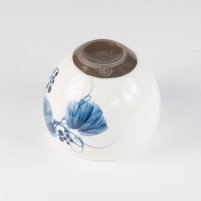Japanese blue-and-white pottery is known as Sometsuke, literally “dye applied”, because the colour was likened to traditional indigo-dyed linen. The ceramics are decorated by hand, stencil or transfer-print with a blue pigment, traditionally cobalt oxide, over which a transparent glaze is then applied, and once fired the underglaze decorations become a vivid shade of blue. This method originated during China’s Song dynasty (960-1279) and is believed to have been perfected around the beginning of the Ming dynasty in the 14th century. Blue-and-white pottery was introduced to Japan at the start of the 17th century in the form of export Tianqi or Ko-Sometsuke ("Old Sometsuke") porcelain from Jingdezhen, which was imitated in the kilns at Arita before spreading to other areas including Kyoto, Seto, Hasami and Mikawachi, each developing their own unique variations of Sometsuke.
Teacup Set of 5
Sometsukesoka
Studio Toan
SKU
1611
A beautiful set of five blue-and-white egg-shaped porcelain teacups each with a unique handpainted floral design. Made at the Tōan Studio in Kyoto, renowned for their exquisite Kiyomizu-yaki ceramics. Suitable for all types of Japanese tea, Senchadō ceremonies and serving to guests.
| Product | 5-piece Teacup Set |
|---|---|
| Ceramic Style | Kyo-/Kiyomizu-yaki |
| Origin | Kyoto, Japan |
| Studio | Tōan 陶あん |
| Volume | 225ml |
| Dimensions | Ø9cm x 7.5cm |
| Weight | 5 x 190g |
| Material | Porcelain |
| Decoration | Blue and white flowers (Sometsuke-sōka 染付草花) |
| Artist's mark | Studio stamp on base |
| Packaging | Wooden box |
Each item is handmade and unique, therefore sizing is approximate and paintings may differ slightly from the product photos
In stock














